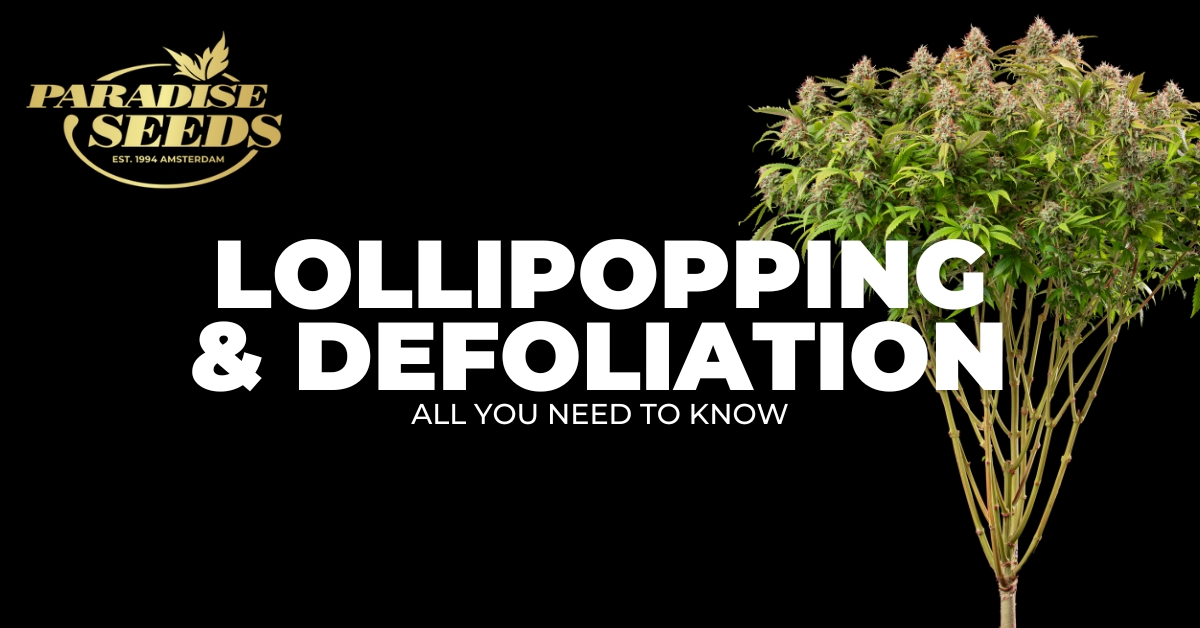This article is a comprehensive guide about two pruning techniques – how to lollipop cannabis plants and how to practice defoliation. Lollipopping and defoliation are popularly used methods which are employed at the end of the veg or beginning of flowering phases to help with cannabis plant management.
Contents
What is the difference between lollipopping and defoliation?
Lollipopping is focused on the lower branches of the cannabis plant i.e. their removal creates a lollipop shaped structure with a bare stem (or stick) with a bushy canopy top.
Defoliation meanwhile focus on targeting some of the top heavy growth in the canopy. The act of thinning out the foliage – essentially fan leaves – to boost bud production and overall yield. See below for more details about defoliation.
What is the lollipop pruning method for weed?
The lollipop pruning method got its name because by removing lower branches and leaving the bulbous canopy behind, the plant resembles a lollipop (well kind of!…).
Lollipopping autoflowers is feasible, but a more common training technique used with photoperiod plants, simply because they are bigger and produce more foliage.
The cannabis lollipop technique involves stripping away the bottom branches of a weed plant. So what does ‘the bottom’ mean in this context. When you lollipop a weed plant you are focusing on the branches on the bottom third – half of the plant.
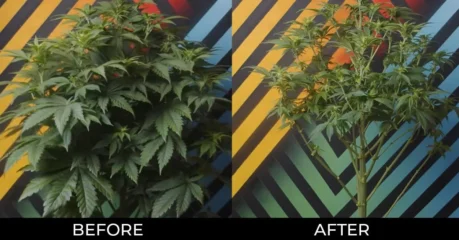
How to lollipop cannabis plants
When lollipopping a cannabis plant it is always a good idea to ensure that tools are sterilized. A pair of sharp scissors is advised for smaller branches, but pruning shears may be necessary for bigger specimens, especially well developed plants grown from outdoor cannabis seeds.
Looking at the plant it will be quite obvious which branches to cut away. The lower branches will be naturally thinner and more spindly with smaller leaves (and underdeveloped bud sites if lollipopping when in flower).
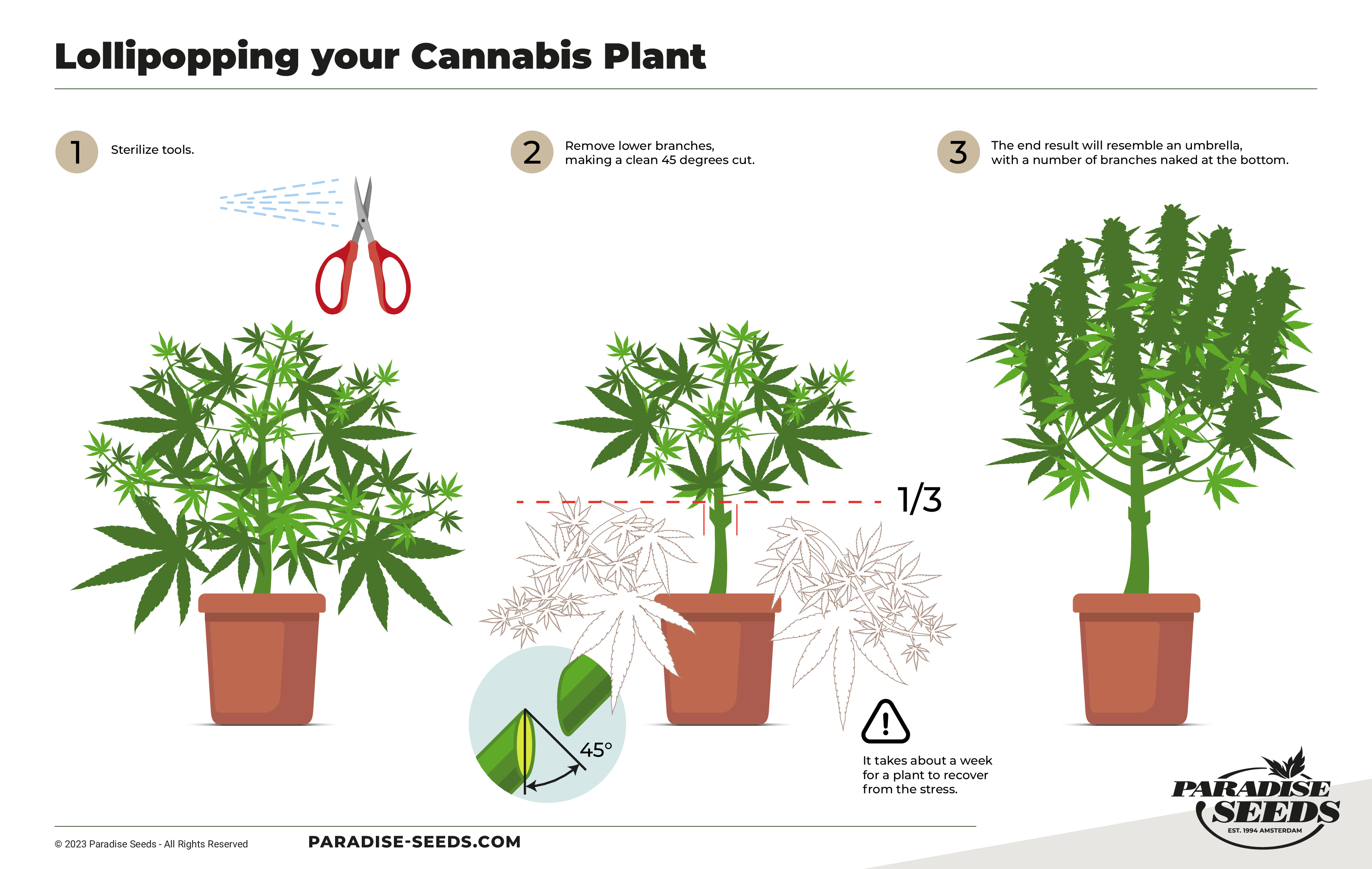
To lollipop a weed plant remove foliage by making a clean cut close to the stem. A good tip is to make this a 45° cut as this will allow water to roll off and stop moisture building up in the wound which may cause infection.
As well as those obvious lower branches, there may also be untidy growth in the middle of the plant. Again you are looking for branches that don’t bring anything to the party – small, twisty, pathetic bud site formation.
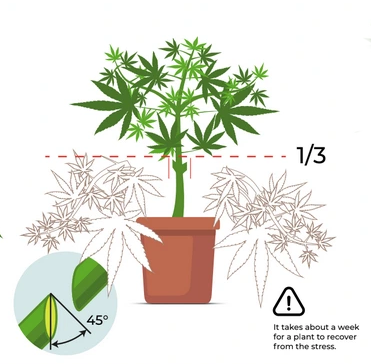
How much to cut away? If you’re unsure then exercise caution. As with all pruning techniques a common mistake made by beginners is to get too carried away. Despite the lollipop term, the end result will more likely resemble an umbrella, with a number of branches, naked at the bottom, coming off the main stem (which will bush up with healthy growth further up into the canopy).
When is it best to use the lollipop pruning method?
As with all growing techniques, and especially training methods, growers tend to have different ideas based on their own growing experience.
Therefore most weed cultivators, growing indoor and outdoor cannabis seeds insist that lollipopping weed plants should take place before the plant has completed its veg stage. There is a logic to this because lollipopping is a medium to high stress training technique which is going to have an impact on your plant.
As a rule of thumb it takes about a week for a plant to recover from the stressful impact of a pruning surgery such as lollipopping.
Following this line of thought, any stress during the flowering period is going to have an impact on the development of the flowers, so why take the risk? However, some growers dispute that this will significantly affect the plant and prefer to lollipop after flowering has commenced as they have a better idea of which bud sites to preserve.
Experimentation is the only way to decide for yourself which approach you are more comfortable with, but it’s advised to set the cut off limit for lollipopping weed plants at 3 weeks into flowering.
Lollipop cannabis plant benefits
- The main reason for lollipopping your weed plant is to channel the plant’s energy away from bottom branches with less productive growth (untidy branches, small leaves and ‘popcorn’ buds) and focus development in the top buds.
- Lollipopping is also a useful technique for improving air circulation around the bottom of the plant to help prevent mold. This is particularly popular for those growing with outdoor cannabis seeds entering a wetter and colder autumn period up to harvest.
- It is used to allow extra light to bud sites where the upper canopy is extra dense, especially if the light source of a grow setup only comes from above.
- It is also used to help with pest control, by effectively cutting out the little critters’ transport network for moving from the grow medium to the top of the plant and from plant to plant due to overlapping foliage.
- Ease of giving water?
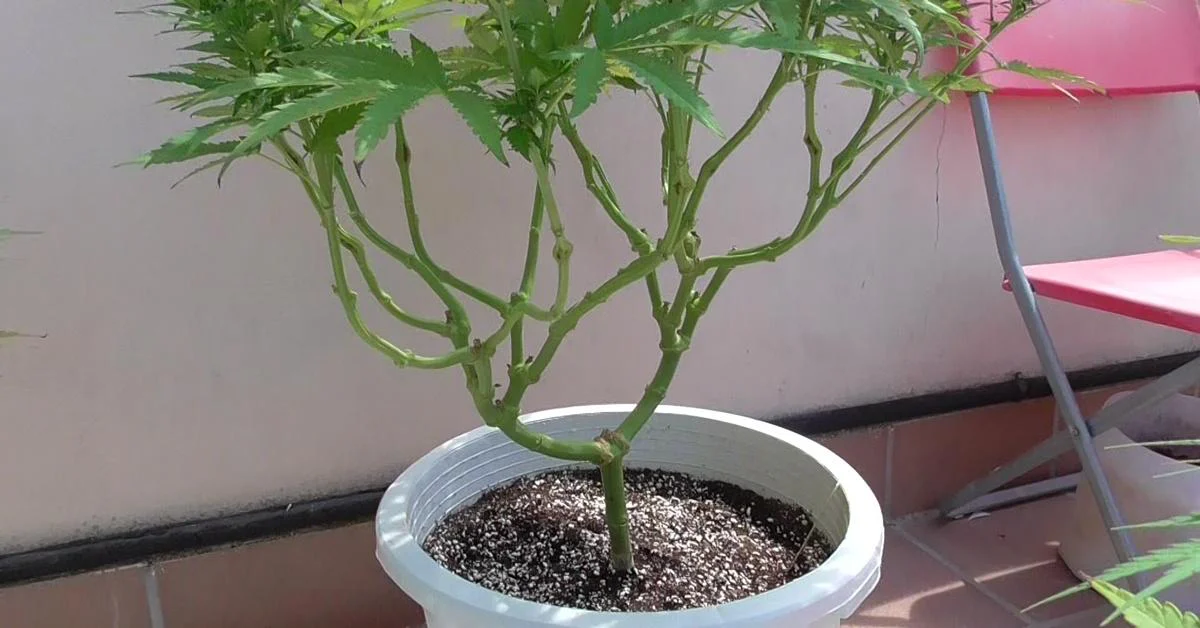
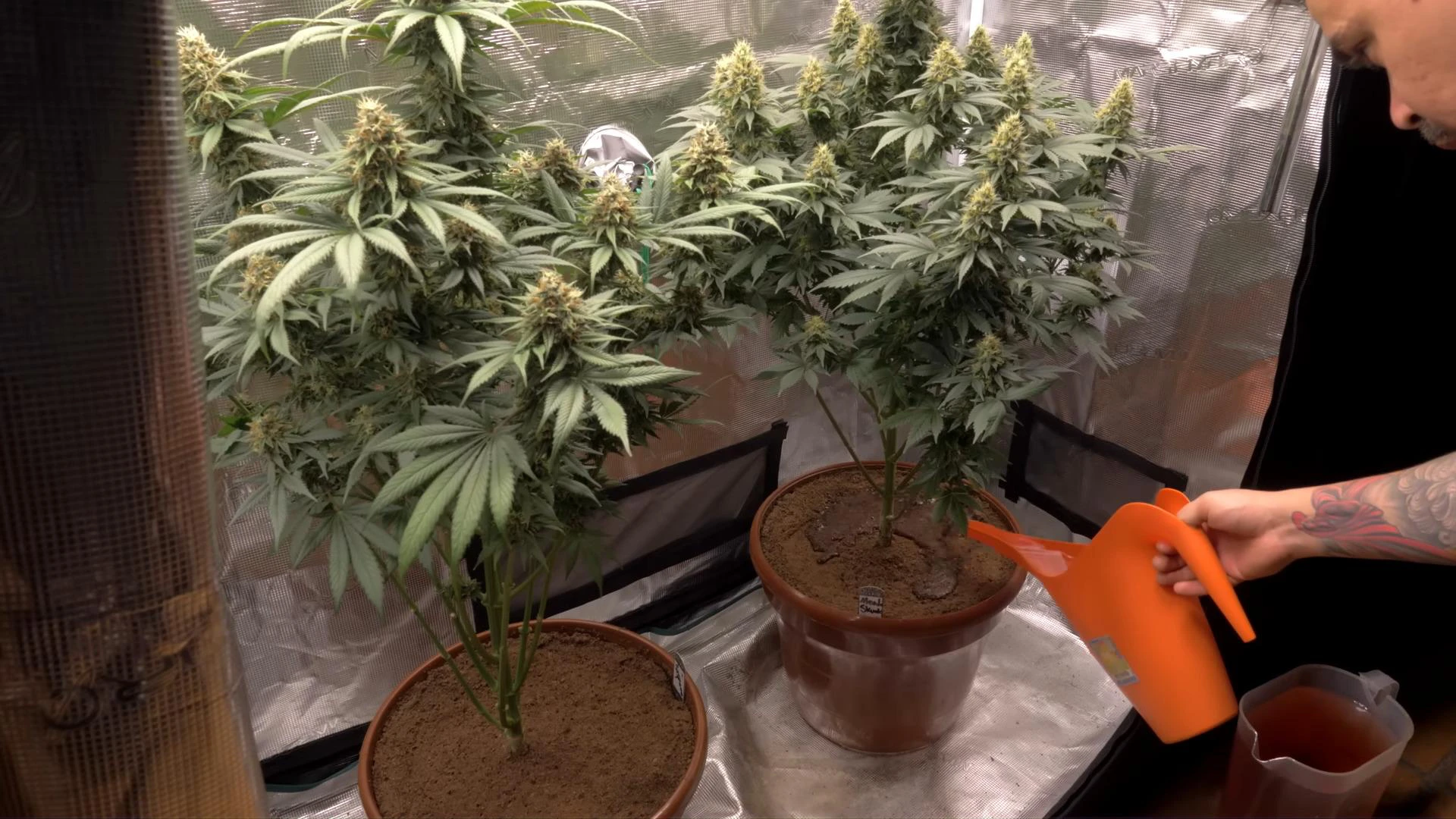
Lollipopping cannabis plants to prevent hermaphroditism in the grow room.
Interesting terpene profiles and additional potency have fuelled the popularity of Californian exotic strains. However, one of the downsides of this new generation of exotics genetics is less stability.
This can sometimes lead to issues in the grow room with hermaphroditism. Pollen sack development tends to occur in the lower branches and lollipopping weed plants can prevent this.
At the same time it creates a clean, manageable space for keeping an eye out for pollen sack development (allowing swift removal before they have a chance to contaminate the rest of the plant.
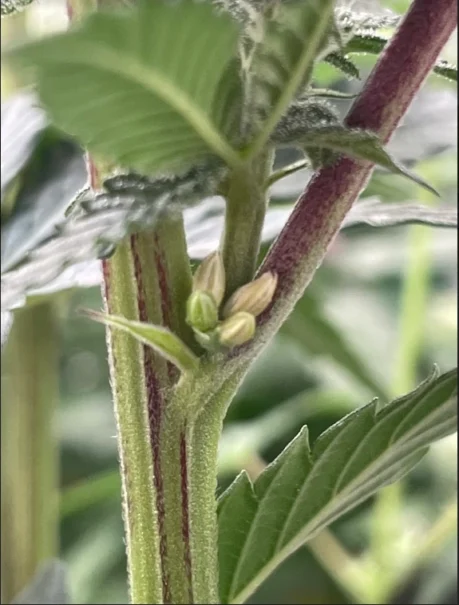
What is cannabis plant defoliation?
Cannabis defoliation is carried out towards the end of the vegging stage and in the early flowering stages. This process is geared towards opening up bud sites to the light and increasing airflow.
Without management, cannabis plants typically grow a cluster of bigger buds at the top of the plant. This corresponds with them receiving all the light. Therefore, one of the aims of defoliation is to increase the light exposure to buds lower down the plant.
The other reason for using the defoliation technique is to boost the air circulation around the plant. If the foliage is too tight around the buds, it creates a kind of micro environment which retains more humidity, which can contribute to mold and mildew developing. By removing leaves to let the air flow better reduces the risk.
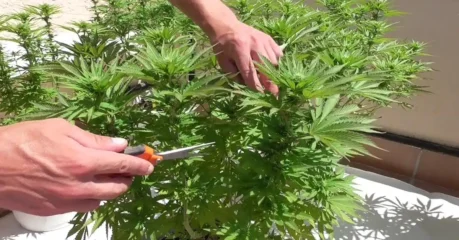
How to defoliate a cannabis plant
Carefully is the answer! It involves cutting away larger leaves to thin out the foliage and stimulate the plant to channel its energies into bud production.
However this process requires a bit of skill and knowledge of plant management. An experienced grower will consider factors such as the general state of health of the plant, and characteristics of the strain.
The biggest mistake frequently made by the inexperienced is to take too many leaves off. This may cause stress to the plant which will stunt its development and disrupt the photosynthesis process which is essential for growth and health.
Therefore the advice is always to go slow – never remove more than 20 – 30% in one session and make sure the plant has a few days of recovery time before doing it again. The safest time to practise this technique is during the veg stage as it approaches the flip to flower. Defoliation should not be carried out later than three weeks into flowering.
Pros and cons of defoliating a cannabis plant
Pros of defoliation:
- Increasing light exposure to lower branches to boost bud production and raise yield.
- Improving airflow to lower the risk of mold and mildew.
- Managing plant structure to shape the canopy and control height and plant density.
Cons of defoliation:
- Can cause stress for the plant, leading to stunted development and weakness which makes it vulnerable to disease.
- Too much trimming at once can damage the plant and impair its ability to photosynthesize, hindering growth.
- Good timing is essential in order not to disrupt the plants natural development cycle.
Conclusion
Lollipopping cannabis plants is a common practice used by experienced growers to manage their weed plants, promote better harvests and reduce the risk of cultivation issues in the flowering phase. Defoliation is used to prune the canopy above. A comination of the two can be used.
Lollipopping is one training technique amongst a handful which are regularly used and if you are interested in learning about other training techniques, our knowledge base also has articles on LST Low Stress Training), SCROG (Screen of Green),SOG (Sea of Green),Super-cropping, topping and fimming.


